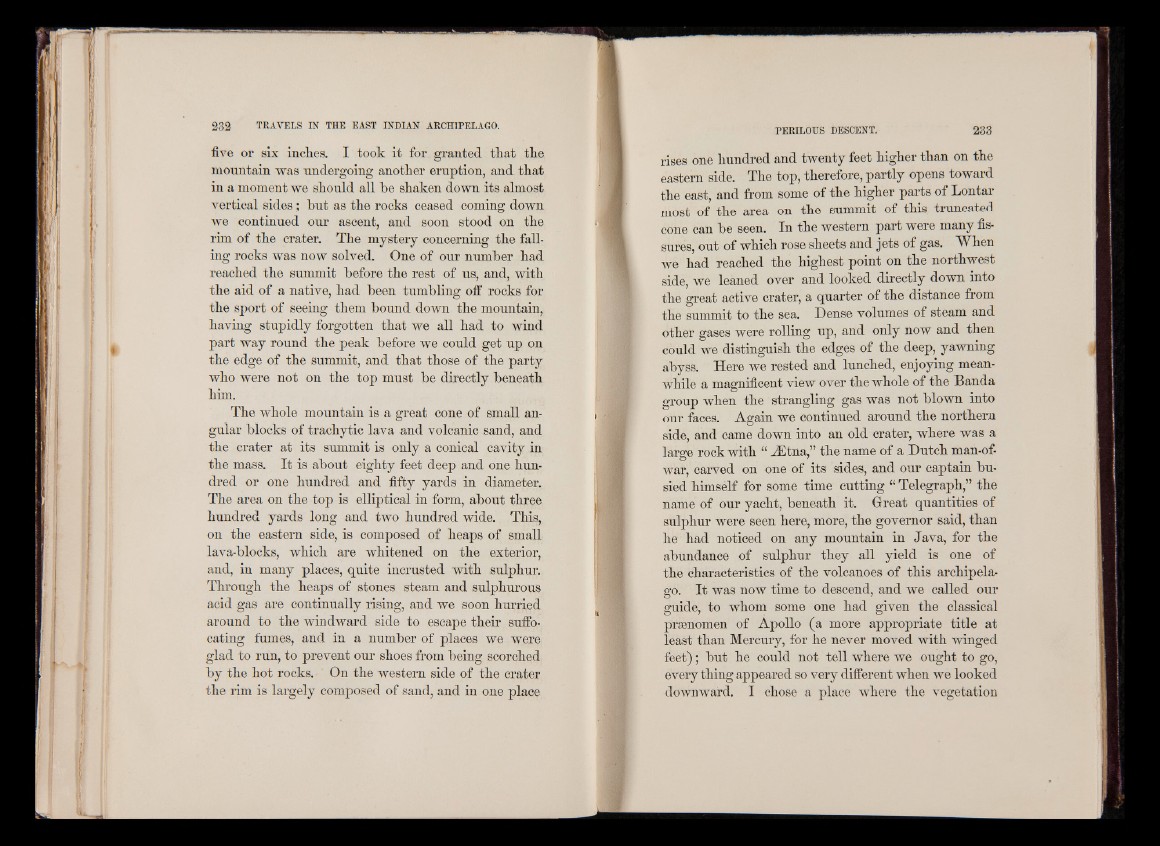
five or six inches. I took it for granted that the
mountain was undergoing another eruption, and that
in a moment we should all he shaken down its almost
vertical sides; hut as the rocks ceased coming down
we continued our ascent, and soon stood on the
rim of the crater. The mystery concerning the falling
rocks was now solved. One of our number had
reached the summit before the rest of us, and, with
the aid of a native, had been tumbling off rocks for
the sport of seeing them bound down the mountain,
having stupidly forgotten that we all had to wind
part way round the peak before we could get up on
the edge of the summit, and that those of the party
who were not on the top must be directly beneath
him.
The whole mountain is a great cone of small angular
blocks of trachytic lava and volcanic sand, and
the crater at its summit is only a conical cavity in
the mass. It is about eighty feet deep and one hundred
or one hundred and fifty yards in diameter.
The area on the top is elliptical in form, about three
hundred yards long and two hundred wide. This,
on the eastern side, is composed of heaps of small
lava-blocks, which are whitened on the exterior,
and, in many places, quite incrusted with sulphur.
Through the heaps of stones steam and sulphurous
acid gas are continually rising, and we soon hurried
around to the windward side to escape their suffocating
fumes, and in a number of places we were
glad to run, to prevent our shoes from being scorched
by the hot rocks. On the western side of the crater
the rim is largely composed of sand, and in one place
rises one hundred and twenty feet higher than on the
eastern side. The top, therefore, partly opens toward
the east, and from some of the higher parts of Lontar
most of the area on the summit of this truncated
cone can be seen. In the western part were many fissures,
out of which rose sheets and jets of gas. When
we had reached the highest point on the northwest
side, we leaned over and looked directly down into
the great active crater, a quarter of the distance from
the summit to the sea. Dense volumes of steam and
other gases were rolling up, and only now and then
could we distinguish the edges of the deep, yawning
abyss. Here we rested and lunched, enjoying meanwhile
a magnificent view over the whole of the Banda
group when the strangling gas was not blown into
our faces. Again we continued around the northern
side, and came down into an old crater, where was a
large rock with I iEtna,” the name of a Dutch man-of-
war, carved on one of its sides, and our captain busied
himself for some time cutting r Telegraph,” the
name of our yacht, beneath it. Great quantities of
sulphur were seen here, more, the governor said, than
he had noticed on any mountain in Java, for the
abundance of sulphur they all yield is one of
the characteristics of the volcanoes of this archipelago.
It was now time to descend, and we called our
guide, to whom some one had given the classical
prsenomen of Apollo (a more appropriate title at
least than Mercury, for he never moved with winged
feet); but he could not tell where we ought to go,
everything appeared so very different when we looked
downward. I chose a place where the vegetation